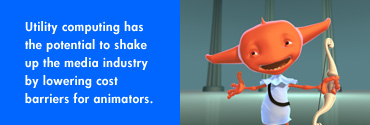
by Julian Richards
Animated Encounters, the Bristol International Animation
Festival, is the biggest annual gathering of animation talent
in the UK and a chance for professionals to talk about the
tools of their trade – most of which are computer-based
these days.
The festival, which opens this week, has the positive habit
of attracting top names. DreamWorks CEO Jeffrey Katzenberg
gives the keynote this year. Matt Groening, creator of The
Simpsons and a former festival headliner, has called
the event "the best place to be if you want to see the
best new cartoons and meet the geniuses behind them."
Groening’s comment is definitely true as far as HP
Labs Bristol is concerned this year. When the festival kicks
off on Thursday 21 April, a group of up-and-coming animators
will proudly show short films they have created using experimental
technologies developed by HP Labs.
The animators are taking part in SE3D (pronounced "seed"),
an experimental project jointly sponsored by HP Labs and
Alias Systems Corp, creator of the award-winning Maya® 3D
rendering software.
The animators, along with researchers from HP Labs Bristol
and industry experts, are presenting a workshop at Animated
Encounters, in which they will show their films, explain
what it was like using the experimental service and join
a debate on how this new technology will change the global
animation industry.
There is already a massive industry shift in animation because
most films now use 3D software for rendering – putting
flesh, color, lighting and detail on animated frames – and
that needs an awful lot of computing power, more than is
available to modest and middle-size animation outfits.
HP, one of the principal sponsors of the festival, is part
of this animation revolution, providing technology and access
to computing power – 120 dual-processor servers in
Palo Alto, CA, completely managed from Bristol – which
only the largest film companies can usually expect to use.
Utility computing takes its name from utilities such as
electricity. The idea is that customers can ‘plug in’ to
enormous amounts of computing power – much more than
is usually available to small- and medium-sized companies – and
pay only for what they have used.
For HP Labs, the animation experiment will investigate how
utility computing will change the technology and economics
of media production and its potential for uncovering new
talent for the animation industry.
"
Utility computing has the potential to shake up the media industry
by lowering cost barriers for animators and others. They can
call on a service like ours when they need it, paying only
for what they use," says Steve Hinde, project manager
for the prototype utility rendering service at HP Labs Bristol. "We
hope services like this could uncover highly talented young
people who would otherwise never be able to work in animation."
The experimental service, which uses the Maya software program
as its rendering engine, is a test bed for a range of innovative
research technologies developed by HP Laboratories.
One of the research projects is an electronic market – spot
and futures – where the 12 animator participants can
bid for processor time. The researchers believe markets are
the fairest and most efficient method of distributing computing
resources.
The 12 filmmakers were selected by an expert media industry
panel. HP Labs provides the animation service and utility
computing resources free of charge, while Alias is providing
Maya software licenses. UK film-funding agencies arranged
funding for showcase participants.
So what did the animators make of the prototype service?
Tia Perkins, who is making Ebenezer Morgan’s Photography
Emporium, with Jaime Pardo, said that the HP Labs service
was perfect for smaller-scale animation companies because
of the access to computing power.
“It is so much quicker and it leaves our own computer
free for us to use," Perkins says. "We can add
extra special effects that we could never use normally, yet
the frames still render in a fraction of the time our own
machines would take."
For more information about the project see www.se3d.co.uk
|
